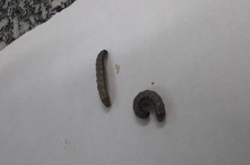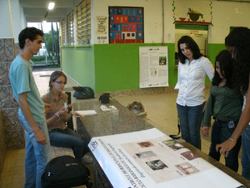Vol.
35 No. 3
May-June 2013
by Renan Bertolin, Milena Avancini, Andréia Matos, and Vânia Gomes Zuin*
Since its emergence in the 1990s, the scientific philosophy called Green Chemistry has become relevant all over the world. This relatively new perspective, especially in the field of education, focuses on the development and improvement of processes and products to reduce or to eliminate the use and generation of hazardous substances.1,2 According to some researchers, Green Chemistry and its 12 principles can provide compelling ways for teachers to interest students in science.3
The authors report some results of a case study conducted at a rural school in São Carlos (São Paulo State, Brazil). The main objective of the project was to investigate the potential to educate Brazilian primary and secondary students about Green Chemistry using a pedagogic activity plan considering environmental topics. The Knowledge Fairs, as part of this project, were based on the control of corn armyworm (Spodoptera frugiperda), an important issue in the school´s region.
 |
| Larvae of S. frugiperda used in the case study. |
S. frugiperda is the major pest of many crops in the Americas and one of the most devastating to tropical maize, causing up to a 34 percent reduction in the overall productivity of this crop in Brazil. Armyworm larvae are usually controlled using pesticides such as piretroids and organophosphates when defoliation is noted in the field.7a,b However, there are many problems associated with using some of these synthetic pesticides; mainly, the likelihood that the worms develop a resistance to the pesticide or that it interferes with natural controls by reducing insect predators and parasitoids of the worms.8 Alternative pest control methods are being pursued, such as botanical insecticides. These insecticides of botanical origin may be an efficient alternative, since they have low mammalian toxicity, lack of neurotoxic action, low persistence in the environment and high biodegradability.9a,b The didactic activity proposed focused on the environmental contamination caused by the indiscriminate use of synthetic pesticides (as organochlorines) and the introduction of new products or methods considered to be less harmful to the environment.
The case study, conducted from 2010–2012, included knowledge fairs, regular classes, and extra-class activities. The research team worked at a rural public school in São Carlos (São Paulo State) as part of the Institutional Scholarship Program for Teaching of the Coordination for the Improvement of Higher Education Personnel program conducted by the Chemistry area of the Federal University of São Carlos (PIBID-CAPES). The fairs encouraged students to consider how knowledge from university research can effect what they learn in school.
For this project, several approaches were used by the research team to teach students about the pest S. frugiperda and its cycle of development, its role in the plantations, and the possibility of using an alternative method for its control. The goal was to spark the students’ interest and curiosity through meaningful learning and how they could understand and apply Green Chemistry in everyday life.
During the fairs and related activities, the students were able to follow the worms’ different stages of development and learn about selected compounds extracted from plants that can control this pest. For instance, azadirachtin, a complex tetranortriterpenoid limonoid from the neem seeds, causes toxic effects in insects. The activities promoted a discussion among the students, researchers and their teachers about how an alternative “greener” process of pest control might be used to combat the armyworm.
Neonate larvae of S. frugiperda were obtained from the Insect Bioassay Laboratory of the Federal University of São Carlos and reared on artificial diets. They were maintained in an incubation chamber with a light phase of 12:12 h L:D, 70 ± 5% relative humidity, and 25 ± 1 °C. The worms’ diets were placed in previously sterilized glass tubes (8.5 cm ± 2.5 cm) into which larvae of S. frugiperda were introduced individually. The obtained pupae were weighed after pupation and were transferred to plastics cups, where they were kept until the emergence of adults.10
 |
| A demonstration at a Knowledge Fair held at a rural school in São Carlos, Brazil. |
The teaching of Green Chemistry as part of environmental education helped students gain a better understanding of the science behind insect-plant interactions. This case study demonstrates that when a didactic activity is transferred to the students’ lives a deeper comprehension of their reality and the improvement of their critical capacity are achieved.11,12 Before and after the fairs, the scientific background to the experiments was dealt with in other forums, including showing documentaries, activities in class, and the demonstration of specimens during the project. It has been shown that class exercises based on local, controversial issues with socio-scientific dimensions have a greater potential to promote scientific literacy.13 The students clearly found the project stimulating as they searched for answers to questions such as “What other chemistry research is carried out by the Federal University of São Carlos?”, ”Is it always green?”, ”How do the researchers know that their projects are within the scope of Green Chemistry?”, “Is it possible to see green products (pesticides) on the Brazilian market?”
It was possible to observe that the didactic approach used in the case study gave the majority of students a better understanding of the recent scientific research programs developed in their own country. Previously, many did not realize that there are green technologies developed in Brazilian universities that can be used to confront our specific environmental problems.
The activities proposed, especially the Knowledge Fairs, provided students with the tools to critically reflect on the issue of pesticide use and opportunities for pest control based on the principles of Green Chemistry and also allowed them to interact with university students, hopefully encouraging them to pursue higher education.
The authors thank the following organizations for their support and assistance: Coordination of Improvement of Higher Education Personnel, the Institute for Biorational Control of Insect Pests, the National Council for Scientific and Technological Development, and the members of the Research and Study Group in Green Chemistry, Sustainability and Education.
*This paper is based on an award winning poster presented at the 4th International IUPAC Conference on Green Chemistry (ICGC-4), Foz do Iguaçu, Brazil, 25–29 August 2012. Corresponding author, Vânia Gomes Zuin <[email protected]>, is a professor in the Chemistry Department of the Federal University of São Carlos, São Carlos, São Paulo, Brazil.
1. P.T. Anastas, J.C. Warner. Green Chemistry: Theory and Practice. Oxford University Press, New York (2000).
2. Tundo, R.H. Rossi. (Eds). Green Chemistry Series N. 11. INCA, Venice (2004).
3. http://www.beyondbenign.org/K12education/kthru12.html (accessed 20 October 2012).
4. V.G. Zuin. Environmental Dimension in Chemistry Teacher Education. Alínea, Campinas (2012).
5. L. Sauvé. Enseñanza de las Ciencias. 28, 1 (2010).
6. Y. Chevallard. La transposition didactique: du savoir savant au savoir enseigné, La Fenseé Sauvage, Paris (1991).
7. (a) I. Cruz, L.J. Oliveira, C.A. Vasconcelos. An. Soc. Entomol. Bras. 25, 2 (1996) (b) I. Cruz. Circular Técnica N. 21. EMBRAPA-CNPMS, Sete Lagoas (1995).
8. F.L. Jesus, A.L. Boiça Jr. In: Tópicos em Entomologia Agrícola II. Funerp, Jaboticabal (2009).
9. (a) C.L. Céspedes, J.S. Calderón, L. Lina, E. Aranda, J. Agric. Food Chem. 48, 1903 (2000) (b) C. L. Céspedes, J.R. Salazar, M. Martínez, E. Aranda. Phytochemistry. 66, 2481 (2005).
10. P. Kasten Jr., A.A.C.M. Precetti, J.R.P. Parra. Rev. Agric. 53, 68 (1978).
11. O. López, J.G. Fernández-Bolaños. Green Trends in Insect Control. RSC Green Chemistry Series, Cambridge (2001).
12. A.S. Cannon, J.C. Warner. K–12 Outreach and science literacy through Green Chemistry. In: P.T. Anastas, I.J. Levy, K.E. Parent. Green Chemistry Education: Changing the Course of Chemistry. ACS Symposium Series, Washington (2009).
13. G.S. Aikenhead. Science Education for Everyday Life: Evidence-Based Practice. Theachers College Press, Columbia University (2006).
Page
last modified 14 May 2013.
Copyright © 2003-2013 International Union of Pure and Applied Chemistry.
Questions regarding the website, please contact [email protected]
|